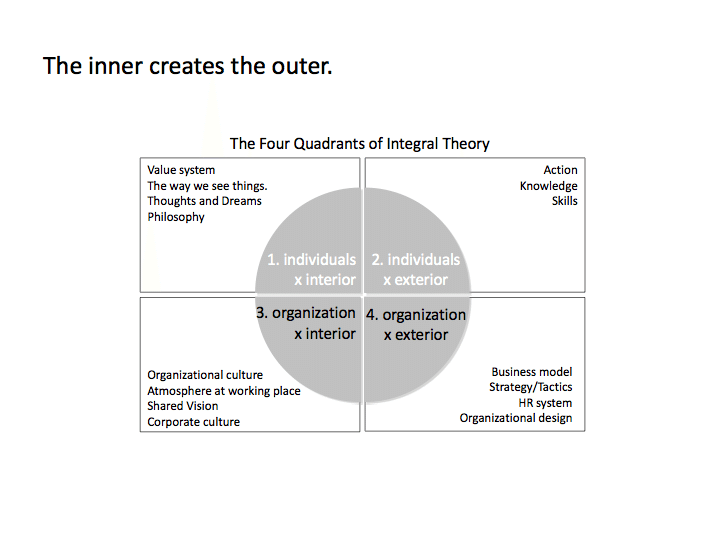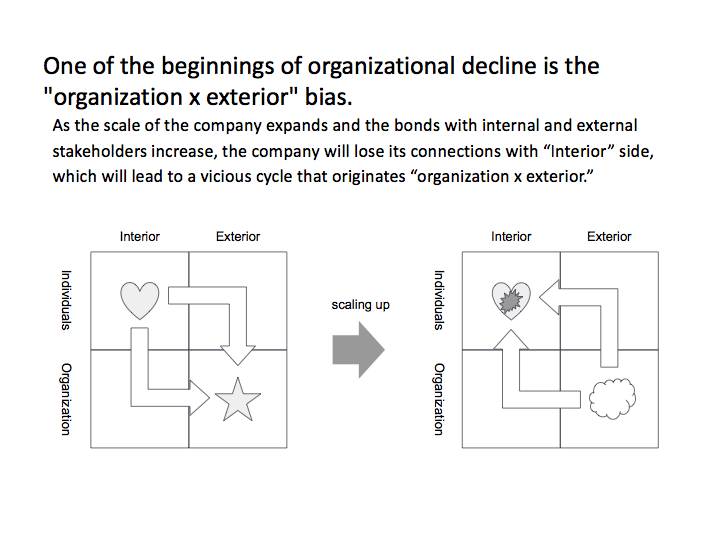
私の課題意識①:目に見えるものへの偏重
初回のノートでは、「経営における矛盾を両立するパラダイムは何か?」について、3+1意識モデル(ミクロ的・微分的視点)や、矛盾を両立する経営の全体像(マクロ的・積分的視点)について述べました。
今回の記事では、このような観点から私たちの社会の現実をみたときに、どのような課題意識を持っているのか、お話ししたいと思います。
見えるものへの偏重
まず第一に課題意識として感じるのが、「見えるものへの偏重」です。具体的には、売上、利益、株価などの財務的な結果であったり、ビジネスモデル、商品、サービス、戦略、人事制度などが「結果として形となって現れるもの」になります。
もちろん、これらのどの要素もビジネスを成立させる上で、とても大切です。一つひとつの要素が大切であることは確かだと思いますが、一方で、これらの要素は、全体からみたときに「目に見えやすい一つの側面」に過ぎないのではないでしょうか?
売上、利益、株価、ビジネスモデル、商品、サービス、人事制度などの形あるものが生み出される過程や経緯を考えれば、それを生み出す組織や人の行動があり、この行動の背景にはひとり一人理想とか、意欲とか、努力など、人の内面から生まれてきたものがあると思うんですね。
例えば、創業者の思いが、組織の文化をつくり、経営理念という言葉になって表現されて、その経営理念を体現するビジネスや組織構造や人事制度が創られる、というストーリーをどの会社も持っているのではないでしょうか。
創業者だけではなく、ある社員1人の思いから始まって多くの人の共感を得て、新しいサービスとなって生み出されるということも、歴史ある企業であれば、いくつものストーリーを持っていると思います。
しかし、時が経ち、市場環境や競争環境が変わり、組織のあり方や組織の構成員も変わっていく中で、いつしか「当初の思い」と「形となって残っているもの」のつながりが薄くなり、形骸化してしまう。そして、形骸化したものが既成事実として残ってしまい、誰もその解消や改善を言い出すことができない。
現在の日本において、よく見られる光景ではないでしょうか?
例えば、教育の話で言えば、今の学校教育の体系は明治時代になってから、欧米の文明をいち早く吸収して文明開化をするという文脈があり、読み・書き・そろばんがしっかりできる教育を全国一律で実施するという考え方をもとに形になってきた経緯があります。
その当時の思想が、今現在においても引き継がれている部分があり、初等教育においては日本の学力が高いと言われる所以になっています。一方で、時代の流れの変化を考えたときに、本当にこの教育の形が良いのかといえば、多くの人が違和感を持っているのではないでしょうか?
例えば、全てのカリキュラムを画一的に実施する教育、先生が説明をして生徒が聞いて理解をするという授業スタイル、答えが一つに定まっている問いに対して、素早く正確に答える能力を育むという考え方。
これらの教育スタイルを全てを否定するものではありませんし、私個人は、このような「型を習得する」学習も大切だと思っていますし、それを「全国一律」でやっていく意義もあると思っています。
しかしながら、このような教育スタイルが、明治時代のときは理念との繋がりがあってよかったものを、今この令和の時代になってもそのままでいいのかと言えば、違和感を持たざるを得ないのではないでしょうか。
内面が外面の変化を創り出す
ここまで、ビジネスモデルや組織構造や人事制度などの「目に見えるもの」と、個人の思いや願いや理念という「目に見えないもの」の両者のつながりが大切であることを述べてきました。
こちらの図をご覧ください。これはケン・ウィルバーのインテグラル理論を元にした図です。

インテグラル理論においては、物事の捉え方には4つの側面があるとされます。この4つの側面のうち、ビジネスにおいて、みなさんが普段注目をしているのはどれでしょうか?あるいは、普段、メディアなどで伝えられることが多いのはどれでしょうか?
「組織×外面」が多いのではないでしょうか?それは、「見えやすく、わかりやすい結果」だからです。組織内において、売上・利益などの財務面の結果、戦略や人事制度などは、言語化しやすく、共有しやすい。個人にとっても、自分の努力の結果を評価や昇進や給与などを通して知ることになりますが、それらは「組織×外面」によって規定されています。

しかし、「組織×外面」にあまりに重視しすぎると、組織の内面や個人の内面とのつながりが切れてしまいます。このつながりが切れてしまうと、内面からのエネルギーの供給がされないので、形骸化して活力を失い、結果的にビジネスとしても儲からなくなります。
逆に、ひとり一人の思いや理想が集合化して、組織の文化となり、それがヴィジョンや人事制度やビジネスモデルを生み出していれば、内面からのエネルギーが常に供給され続けますので、結果的にビジネスとしてもうまくいきます。
私が大切にしたい「主体的真理の社会実装」というのは、「個人×内面」の主体的真理から始まって、「組織×外面」の社会実装に至る、この2つの間のつながりが保たれている状態です。そして、その出発点は「組織×外面」ではなく、「個人×内面」であるということです。
「組織×外面」がダメという話ではありません。「個人×内面」とのつながりがきれてしまうこと、さらに言えば、つながりがきれたときに形骸化したまま、そのつながりを取り戻すことができない状態が続いてしまうことに、私の課題意識があります。
本日の問いとなります。(よろしければ、コメントにご意見ください)
・あなたが所属している会社や組織や学校において、集団としての意識の重心は、インテグラル理論の4象限のうち、どこにありますか?それは、どのような事象を見て、そう思ったのでしょうか?
・「個人×内面」から始まって「組織×外面」に影響を与えていったストーリーと言えば、どのようなストーリーを思い浮かべますか?
My recognition of issues vol.1: the bias for the visible.
In my first note, "What is the paradigm for integrating contradictions in management?" I discussed the 3+1 consciousness model (micro and differential perspectives) and the overall picture of management that integrates contradictions (macro and integral perspectives).
An overemphasis on what we can see
First and foremost, I feel that the first issue is an overemphasis on what we can see. Specifically, it could be financial results such as sales, profits, stock price, etc., or it could be the business model, products, services, strategies, HR systems, etc. that "take shape as a result."
All of these elements are very important to the success of a business, but on the other hand, they are only one aspect of whole businesses that is easily visible, aren't they?
If you think about the process or the history of creating something visible/tangible, such as sales, profits, stock prices, business models, products, services, and human resource systems, you will find that the organization and people who create them take actions, and behind these actions are the ideals, motivations, and efforts of each individual.
For example, every company has a story in which the founder's passion and philosophy create the culture of the organization, which is expressed in the form of a management philosophy, and then the business, organizational structure, and personnel system are created to embody it.
If a company has a long history, it may have a number of stories, not only about the founder, but also about how a single employee's idea, which gained the sympathy of many people, became a new product or a service.
However, as time goes by, the market and competitive environment changes, and the nature of the organization and its members change, the connection between the "original passion and philosophy" and the "actual form of business and organization" fades and becomes a skeleton. What remains in the form of a skeleton remains as an established fact, and no one is able to propose its dissolution or improvement.
Isn't this a common scene in today's Japan?
For example, speaking of education, the current school education system was formed during the Meiji era (1868-1912) in the context of absorbing Western civilization as early as possible to civilize the country, and it was based on the idea of providing a uniform education that would enable students to read, write, and do the abacus well.
Some of the ideas from that time have been carried over to the present day, and this is the reason why Japan is said to have high academic standards in elementary education. On the other hand, many people may be uncomfortable about whether or not this type of education is really a good idea when considering the changes of the times.
For example, an education that implements all curricula in a uniform way, a teaching style where the teacher explains and the students listen and the idea of fostering the ability to quickly and accurately answer questions that have a single, fixed answer.
I don't deny all of these teaching styles, and I personally believe that this type of "mastering the pattern" learning is important, and I think it's worthwhile to do it "uniformly" across the country.
However, I am not sure if this style of education, which was good in the Meiji era (1868-1912) because of its connection to the philosophy at that time, should be totally maintained in this era of Reiwa.
The inner creates the outer
We have discussed the importance of the connection between the "visible" things, such as business models, organizational structures and HR systems, and the "invisible" things, such as individual thoughts, wishes and principles.
This is a figure based on Ken Wilber's Integral Theory.

In Integral Theory, there are four aspects of the way we perceive things. Which of these four aspects do you usually focus on in business? Or which one is usually communicated in the media?
I think it's "organization x external." This is because the results are easy to see and understand. Within an organization, financial results such as sales and profits, strategies and HR systems are easy to verbalize and share. For individuals, they will also know the results of their efforts through evaluations, promotions, salaries, etc., which are defined by "organization x external".

However, if too much emphasis is placed on "organization x external", the connection between the inner workings of the organization and the inner workings of the individual is severed. When this connection is broken, energy is not supplied from within, and the organization loses its vitality, and as a result, it becomes unprofitable as a business.
On the other hand, if the thoughts and ideals of each individual are aggregated to create an organizational culture, which in turn creates a vision, human resource system, and business model, there is a constant supply of energy from within, and as a result, the business will be successful.
What I would like to emphasize is the "social implementation of the subjective truth", which begins with the subjective truth in "Individuals x Interior" and ends with the social implementation in "Organization x Exterior", and the connection between the two is maintained. The starting point is not "Organization x Exterior" but "Individuals x Interior".
I'm not talking about "Organization x Exterior" being a bad thing. I have a sense of challenge that the connection with "Individuals x Interior" is broken, and more importantly, that when the connection is broken, it remains a skeleton and the connection cannot be regained.
Here are the quests of the day. (If you'd like, please share your thoughts in the comments.)
・In your company, organization, or school, which is the focus of the group consciousness among the four quadrants of integral theory? What events did you see that make you think that?
・When you think of stories that started with "Individuals x Interior" and influenced "Organizations x Exterior," what kind of stories come to mind?
Bunshiro Ochiai
この記事が気に入ったらサポートをしてみませんか?
